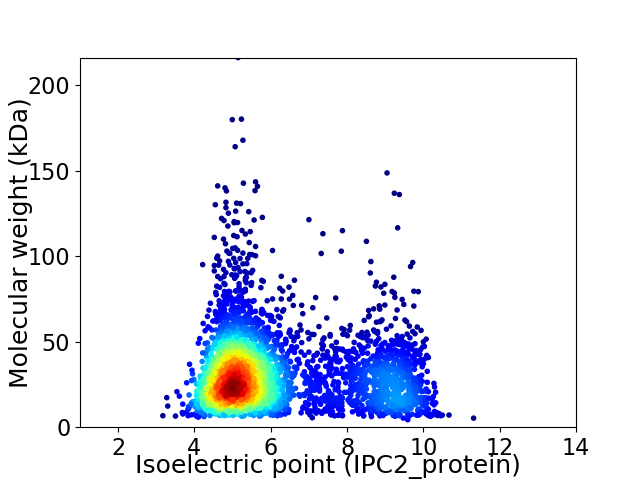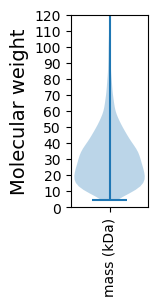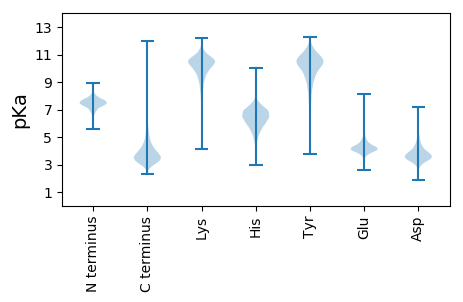
Luteipulveratus halotolerans
Taxonomy: cellular organisms; Bacteria; Terrabacteria group; Actinobacteria; Actinomycetia; Micrococcales; Dermacoccaceae; Luteipulveratus
Average proteome isoelectric point is 6.16
Get precalculated fractions of proteins

Virtual 2D-PAGE plot for 3827 proteins (isoelectric point calculated using IPC2_protein)
Get csv file with sequences according to given criteria:
* You can choose from 21 different methods for calculating isoelectric point
Summary statistics related to proteome-wise predictions



Protein with the lowest isoelectric point:
>tr|A0A0L6CH81|A0A0L6CH81_9MICO Proteasome protein OS=Luteipulveratus halotolerans OX=1631356 GN=VV01_07880 PE=4 SV=1
MM1 pKa = 7.86SEE3 pKa = 4.36LEE5 pKa = 4.11YY6 pKa = 10.25PADD9 pKa = 3.42LRR11 pKa = 11.84YY12 pKa = 8.7TGDD15 pKa = 3.84HH16 pKa = 6.32EE17 pKa = 4.42WVADD21 pKa = 3.65KK22 pKa = 11.31GDD24 pKa = 3.45GVVRR28 pKa = 11.84VGITAYY34 pKa = 10.48AQDD37 pKa = 3.56ALGDD41 pKa = 3.79VVYY44 pKa = 11.12VSLPAVGDD52 pKa = 3.64AVTAGDD58 pKa = 3.41SCGEE62 pKa = 4.14VEE64 pKa = 4.44STKK67 pKa = 10.7SVSDD71 pKa = 4.11LYY73 pKa = 11.49SPLEE77 pKa = 4.22GEE79 pKa = 4.51VVAVNDD85 pKa = 4.57ALDD88 pKa = 4.04GAPEE92 pKa = 4.13QVNSAPYY99 pKa = 9.06GDD101 pKa = 3.08GWMFEE106 pKa = 4.39MKK108 pKa = 10.45VADD111 pKa = 3.91PAAIEE116 pKa = 4.13ALLDD120 pKa = 3.48VEE122 pKa = 5.2AYY124 pKa = 9.4KK125 pKa = 10.06ATLGG129 pKa = 3.68
MM1 pKa = 7.86SEE3 pKa = 4.36LEE5 pKa = 4.11YY6 pKa = 10.25PADD9 pKa = 3.42LRR11 pKa = 11.84YY12 pKa = 8.7TGDD15 pKa = 3.84HH16 pKa = 6.32EE17 pKa = 4.42WVADD21 pKa = 3.65KK22 pKa = 11.31GDD24 pKa = 3.45GVVRR28 pKa = 11.84VGITAYY34 pKa = 10.48AQDD37 pKa = 3.56ALGDD41 pKa = 3.79VVYY44 pKa = 11.12VSLPAVGDD52 pKa = 3.64AVTAGDD58 pKa = 3.41SCGEE62 pKa = 4.14VEE64 pKa = 4.44STKK67 pKa = 10.7SVSDD71 pKa = 4.11LYY73 pKa = 11.49SPLEE77 pKa = 4.22GEE79 pKa = 4.51VVAVNDD85 pKa = 4.57ALDD88 pKa = 4.04GAPEE92 pKa = 4.13QVNSAPYY99 pKa = 9.06GDD101 pKa = 3.08GWMFEE106 pKa = 4.39MKK108 pKa = 10.45VADD111 pKa = 3.91PAAIEE116 pKa = 4.13ALLDD120 pKa = 3.48VEE122 pKa = 5.2AYY124 pKa = 9.4KK125 pKa = 10.06ATLGG129 pKa = 3.68
Molecular weight: 13.5 kDa
Isoelectric point according different methods:
Protein with the highest isoelectric point:
>tr|A0A0L6CM08|A0A0L6CM08_9MICO ATP-binding protein OS=Luteipulveratus halotolerans OX=1631356 GN=VV01_18400 PE=3 SV=1
MM1 pKa = 7.69SKK3 pKa = 9.0RR4 pKa = 11.84TFQPNNRR11 pKa = 11.84RR12 pKa = 11.84RR13 pKa = 11.84AKK15 pKa = 9.97KK16 pKa = 9.33HH17 pKa = 4.25GFRR20 pKa = 11.84LRR22 pKa = 11.84MRR24 pKa = 11.84TRR26 pKa = 11.84AGRR29 pKa = 11.84AVLASRR35 pKa = 11.84RR36 pKa = 11.84SKK38 pKa = 10.74GRR40 pKa = 11.84ARR42 pKa = 11.84LSAA45 pKa = 3.91
MM1 pKa = 7.69SKK3 pKa = 9.0RR4 pKa = 11.84TFQPNNRR11 pKa = 11.84RR12 pKa = 11.84RR13 pKa = 11.84AKK15 pKa = 9.97KK16 pKa = 9.33HH17 pKa = 4.25GFRR20 pKa = 11.84LRR22 pKa = 11.84MRR24 pKa = 11.84TRR26 pKa = 11.84AGRR29 pKa = 11.84AVLASRR35 pKa = 11.84RR36 pKa = 11.84SKK38 pKa = 10.74GRR40 pKa = 11.84ARR42 pKa = 11.84LSAA45 pKa = 3.91
Molecular weight: 5.3 kDa
Isoelectric point according different methods:
Peptides (in silico digests for buttom-up proteomics)
Below you can find in silico digests of the whole proteome with Trypsin, Chymotrypsin, Trypsin+LysC, LysN, ArgC proteases suitable for different mass spec machines.| Try ESI |
 |
|---|
| ChTry ESI |
 |
|---|
| ArgC ESI |
 |
|---|
| LysN ESI |
 |
|---|
| TryLysC ESI |
 |
|---|
| Try MALDI |
 |
|---|
| ChTry MALDI |
 |
|---|
| ArgC MALDI |
 |
|---|
| LysN MALDI |
 |
|---|
| TryLysC MALDI |
 |
|---|
| Try LTQ |
 |
|---|
| ChTry LTQ |
 |
|---|
| ArgC LTQ |
 |
|---|
| LysN LTQ |
 |
|---|
| TryLysC LTQ |
 |
|---|
| Try MSlow |
 |
|---|
| ChTry MSlow |
 |
|---|
| ArgC MSlow |
 |
|---|
| LysN MSlow |
 |
|---|
| TryLysC MSlow |
 |
|---|
| Try MShigh |
 |
|---|
| ChTry MShigh |
 |
|---|
| ArgC MShigh |
 |
|---|
| LysN MShigh |
 |
|---|
| TryLysC MShigh |
 |
|---|
General Statistics
Number of major isoforms |
Number of additional isoforms |
Number of all proteins |
Number of amino acids |
Min. Seq. Length |
Max. Seq. Length |
Avg. Seq. Length |
Avg. Mol. Weight |
|---|---|---|---|---|---|---|---|
0 |
1160312 |
37 |
2006 |
303.2 |
32.54 |
Amino acid frequency
Ala |
Cys |
Asp |
Glu |
Phe |
Gly |
His |
Ile |
Lys |
Leu |
|---|---|---|---|---|---|---|---|---|---|
12.987 ± 0.048 | 0.726 ± 0.011 |
6.66 ± 0.04 | 5.414 ± 0.043 |
2.613 ± 0.023 | 8.98 ± 0.039 |
2.306 ± 0.018 | 3.514 ± 0.027 |
2.166 ± 0.03 | 9.947 ± 0.045 |
Met |
Asn |
Gln |
Pro |
Arg |
Ser |
Thr |
Val |
Trp |
Tyr |
|---|---|---|---|---|---|---|---|---|---|
1.939 ± 0.016 | 1.69 ± 0.019 |
5.469 ± 0.029 | 3.144 ± 0.022 |
7.725 ± 0.043 | 5.566 ± 0.029 |
6.267 ± 0.035 | 9.33 ± 0.039 |
1.562 ± 0.018 | 1.998 ± 0.02 |
Most of the basic statistics you can see at this page can be downloaded from this CSV file
Proteome-pI is available under Creative Commons Attribution-NoDerivs license, for more details see here
| Reference: Kozlowski LP. Proteome-pI 2.0: Proteome Isoelectric Point Database Update. Nucleic Acids Res. 2021, doi: 10.1093/nar/gkab944 | Contact: Lukasz P. Kozlowski |
